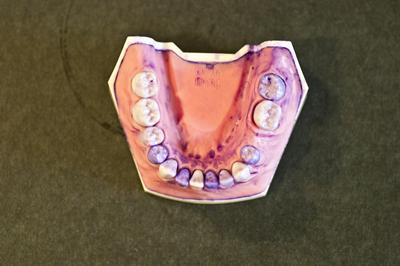Southampton invention successfully removes biofilms that cause dental caries

The Journal of Dental Research (Impact Factor 4.688) today published a paper showing how the StarStream© ultrasonic cleaning system (invented at the University of Southampton) is effective at removing biofilms of bacteria that area known causes of dental caries, specifically Streptococcus mutans UA159, as well as Actinomyces naeslundii ATCC 12104 and Streptococcus oralis ATCC 9811.
StarStream© is particularly good at cleaning in crevices that normal cleaning methods find difficult to clean
This was demonstrated in this study by growing the bacterial biofilms on etched glass, the etching creating complicated contoured surfaces. Artificial teeth from a detail training model were also used. Biofilm removal was assessed both visually and microscopically using high-speed videography, confocal scanning laser microscopy (CSLM), and scanning electron microscopy (SEM). Analysis by CSLM demonstrated a statistically significant 99.9% removal of S. mutans biofilms exposed to the UAS for 10 s, relative to both untreated control biofilms and biofilms exposed to the water stream alone without ultrasonic activation (P < 0.05). The water stream alone showed no statistically significant difference in removal compared with the untreated control (P = 0.24). High-speed videography demonstrated a rapid rate (151 mm2 in 1 s) of biofilm removal.

Before cleaning
Dental biofilm is revealed by the blue dye

Using plain water
After 10 seconds of using water only, without Starstream bubbles

Using Starstream
Results 10 seconds after turning the Starstream bubbles on
Professor Paul Stoodley and his fellow authors, began the study funded by the 2011 Royal Society Brian Mercer Award for Innovation. They continue to collaborate under the Network for Anti-Microbial Resistance and Infection Prevention (NAMRIP).
Professor Tim Leighton said: “Winning the Brian Mercer Award that funded this scheme has been of enormous benefit. We are very grateful to the sponsors for backing a story that takes fundamental research into commercialization, and then back into fundamental research where people can access the commercial StarStream© devices that we developed with Ultrawave Ltd., and use those devices for fundamental research on how well they clean and combat infection. This paper is the first in what will be a series of peer-reviewed papers on how well StarStream cleans in a variety of scenarios, using just cold water. We could not publish until the patent was secure, but now that it is, I am delighted to see the work of all the marvellous collaborations, across a range of disciplines, finally get published in peer review journals. I was delighted to see StarStream work so effectively against dental biofilms – the dental environment, antibiotic stewardship in oral healthcare, and the associated use and of instruments, are all key to the strategy to combat antimicrobial resistance and ensure the prevention of infection.
Citation
Howlin, R.P., Fabbri, S., Offin, D.G., Kiang, K.S., Knee, R.J., Yoganantham, D.C., Webb, J.S., Birkin, P.R.,Leighton, T.G. and Stoodley, P. (2015) Removal of dental biofilms with an ultrasonically-activated water stream.
The data for this paper are archived here
We are thrilled with the results of this study. Despite twice daily brushing, and even flossing, some bacteria can remain in the hard to reach nooks and crannies of the teeth and gums. These pockets of bacteria can produce acids that dissolve tooth enamel and they can also inflame the gums causing bleeding. These pockets can also reseed the cleaned areas so the dental plaque may grow back there more quickly. Over time these pockets become calcified into hard deposits of calculus or tartar and are the reason that an annual or twice yearly visit to a dental hygienist is required, to remove the tartar with scalers, which are like small pick axes. If ultrasonically activated bubble technology can more effectively remove these bacteria from the pockets then hopefully there will be fewer visits to the dentist for fillings, root planing, crowns and ultimately extractions!
This paper has been the culmination of a lot of hard work from a number of researchers in an exciting collaboration bridging engineering, microbiology and industry and its great to see the work published. The research into ultrasonically activated streams as a tool for biofilm removal in dentistry is an early example of the benefit of the University of Southampton’s Network for Anti-Microbial Resistance and Infection Prevention (NAMRIP) group and the productivity that can be achieved in bringing researchers together around a common theme
Notes for editors
NAMRIP is funded by the University of Southampton and benefits hugely from £868,704.00 of funding from EPSRC's Network for Antimicrobial Action 'Bridging the Gap' call [].
The MRC has also invested in NAMRIP, with Syma Khalid and Paul Elkington projects.
